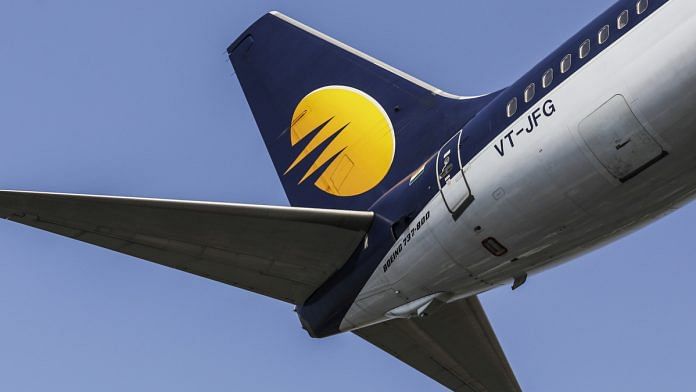New Delhi: Jet Airways ending operations and a combination of many other factors such as high fares and the overall economic slowdown in India have led to a decline in aircraft movement over Indian skies this year compared to the last.
Jet Airways, India’s oldest privately owned airline with a fleet of 119 planes, stopped operations in April after it ran out of funds.
The monthly air traffic report released last week by the Airports Authority of India showed that international air traffic decreased by 4.2 per cent between April and August 2019, as compared to the same period last year. Domestic air traffic fell by 0.6 per cent during the same period. The overall decrease is 1.2 per cent.
Arun Kumar, the Director General of Civil Aviation, explained aircraft movement as “an aircraft take-off or landing at an airport”.
“For airport traffic purposes, one arrival and one departure is counted as two movements. For example, one trip from Delhi to Chandigarh will include two movements — one at IGIA (Indira Gandhi International Airport) and another at CHD (Chandigarh Airport),” he said.
The Directorate General of Civil Aviation’s monthly traffic and operating statistics also showed a decline in Air India’s domestic aircraft movement in July 2019 compared to the preceding four months.
Domestic passenger growth has also gone down from double digits in 2018 to single digits in 2019. According to DGCA’s August air traffic report, the annual growth in domestic passenger traffic in 2019 was estimated to be 3.24 per cent, down from 21.2 per cent in 2018.
The monthly domestic passenger traffic growth in 2019 is estimated at 3.87 per cent, compared to the previous year’s 17.7 per cent.
The only silver lining is that the downward trend — in aircraft movement, at least — seems to be levelling off. The numbers for August 2019 saw a 0.4 per cent increase compared to August 2018.
The last time one of AAI’s monthly reports had shown a positive trend was in February 2019, when aircraft movement and passenger load factor had increased by 4.9 per cent and 3.1 per cent, respectively, over the corresponding month the previous year.
Also read: Boeing is now in ‘endgame’ of getting 737 Max back in the air, says CEO
Reasons for the decline
A senior official of the Directorate General of Civil Aviation (DGCA), said the main reason for the decline was the closure of Jet Airways.
“At present, we have over 600 planes in the Indian skies, even after Jet’s 119 planes were grounded. Some planes of other airlines remain grounded for maintenance,” the official said.
Aerospace analyst Saj Ahmad added: “This decline is likely driven by the collapse of Jet and the vast swathe of its fleet being repossessed, coupled with the loss of traffic to non-Indian airlines for international services, because the only Indian option to places like Europe and the US is Air India. I would not be surprised if passengers were flying other airlines or scrapping travel plans altogether.
“There are likely other catalysts such as the never-ending engine woes on IndiGo’s Airbus A320neo fleet, much of which was parked for several weeks earlier in the spring pending engine fixes. That must have hampered demand as well.”
Economic slowdown
Sudhakara Reddy, national president of the Air Passengers Association of India (APAI), agreed that the collapse of Jet was a factor, but he also pointed out two more — the “high airfares being charged by the top four airlines IndiGo, SpiceJet, Air India and GoAir”, and the slowdown in India’s economic growth.
Mark Martin, founder of aviation consultancy firm Martin Consulting, agreed with Reddy.
“The decline in aircraft movement was expected. The aviation sector usually grows at twice the GDP growth, but if GDP growth falls, the aviation sector drops drastically. The worst part is that the passenger load factor, which should have increased, has also reduced,” Martin said.
“(The numbers) are a collective result of what happened with Jet Airways, and Boeing’s 737 MAX and Airbus’ A320neo planes being grounded. It has been extremely harsh on the aviation industry and it has not helped it recover in any way.”
Also read: Insolvency plea against Jet Airways — here’s what lies ahead for the airline
(An earlier version of this report had attributed a quote to B.S. Bhullar, identifying him as the DGCA chief. However, the quote is actually from current DGCA chief Arun Kumar, and the report has been updated to reflect that. The error is regretted.)



